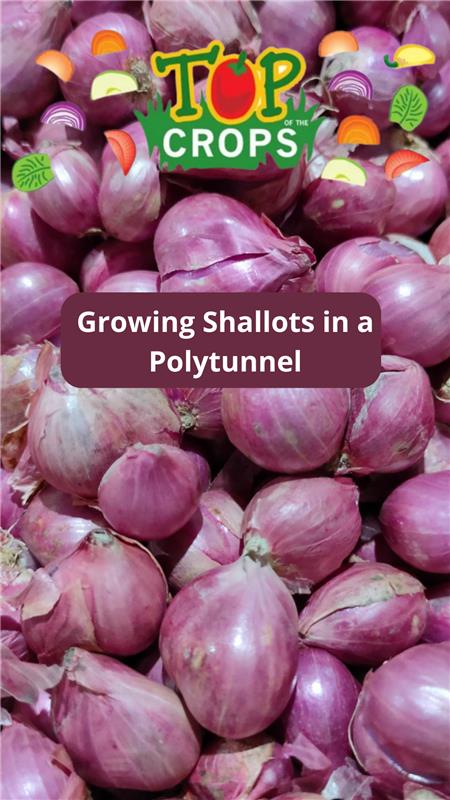Welcome to Top of the Crops. Today, you will learn about growing shallots in a polytunnel. Also, for more gardening tips, don't forget to check out our gardening blog Polytunnel Gardening.
Shallots are a great-value crop that can be a good value addition to your polytunnel. Not only will these bulbs impart a delicate onion taste to a variety of dishes, they will also, as an allium, help to repel a wide range of common polytunnel pests.
Shallots are vegetables grown for their bulbs that belong to the same genus and sometimes the same species as the common bulb onion, Allium cepa, but which are in a different cultivar group.
Though they do need a long growing period, they can take up little space and can easily be inter-planted with other crops to make the most of the space in your polytunnel.
What is more, though they are commonly grown as annuals and harvested in a single growing season, the bulbs multiply and so can provide food potentially over a number of years when the offsets or sets are replanted.
| Jan | Feb | Mar | Apr | May | Jun | Jul | Aug | Sep | Oct | Nov | Dec | |
| Sow |  |
 |
 |
|||||||||
| Plant |  |
 |
 |
 |
 |
 |
||||||
| Harvest |  |
 |
To grow shallots, you need to make sure that you meet their basic growing conditions. In order to grow well, shallots require:
Full sun.
A sheltered site.
Well-drained, fertile soil or growing medium rich in organic matter, with a pH above 6.5.
To grow shallots you will need:
Shallot sets or seeds.
A suitable growing location, or container, for growing shallots.
Trays or small pots, seed-starting growing medium etc. if growing from seed.
Trowel for planting sets.
Facility to water your crop.
Organic matter for mulch/ feeds.
Hoe or other tools for weeding.
Though they can be grown from seed, shallots are usually grown from sets (immature bulbs). These are easier to work with and will be better in colder regions. They are quicker to mature and less likely to be weeded out by mistake or lost when very small. Sets are also less likely to be beset by pests and diseases.
If you would like to grow shallots then of course you will first have to decide which variety or varieties to grow, and where you will grow them. Read on because we have some variety suggestions later in this guide.
You will need to prepare the ground, and also decide whether you will grow from sets or seeds. Details of the different methods involved are given below.
Shallots like a fertile soil and so it is best to add a good quantity of organic matter/ good quality organic compost to your soil before planting.
Shallot sets can be planted any time between mid-November and mid-April. Some less sensitive varieties are planted through late autumn or winter, while most are sown in the spring, from mid March onwards.
In drier, less heavy soils, autumn planting is an option but this is not really a good idea in areas where the soil may become waterlogged. Some varieties are more sensitive to cold and cold temperatures may cause them to bolt.
Plant the sets into holes or drills 2cm deep. Gently push them into a soft, well prepared growing area so that the tip is just showing and firm the soil around them. You should aim for a spacing of around 15-20cm and if you are doing more than one row, these should usually be between 30 and 45cm apart.
Sometimes birds can cause problems by pulling sets newly planted from the ground. If this becomes an issue you can cover your crop until the sets form roots and are more firmly anchored in the soil.
Mulch around the sets with organic matter to reduce weed growth, conserve soil moisture and improve the drainage capacity of the soil over time.
Growing shallots from seed does take a little more time, work and effort, but seeds are the cheaper option. One other thing to note is that seed-grown shallots are less likely to bolt.
To get a good crop shallot seeds must have germinated and be growing well by the end of the spring. Lengthening days spur bulb formation and so the more foliage the plant has at this time, the bigger and better the shallot bulbs will be.
Seeds can either be sown indoors or outside.
Shallot seeds should be sown in late winter into modular trays or small pots. It is normal to sow around 5 seeds per module/ pot and then thin as necessary to leave 3-4. only one bulb will come from each seed to sowing multiple seeds together and keeping them together gives clumps of bulbs.
Temperatures of between 10 and 16 degrees are needed for germination and using a heated propagator, while not essential, can make germination rates improve. Shallot seedlings should emerge within a couple of weeks.
Once the seeds sprout, remove them from the propagator if you used one, and place them in a warm and bright location. Keep watering them to maintain moist growing medium, then, in spring, harden off the young plants and plant them out into their final growing locations. Keep your seedlings in clumps, spacing the clumps 15-20cm apart, in rows spaced 30-45cm apart.
Alternatively, if you prefer direct sowing, do so into a well-prepared growing area. Usually the seeds are sown thinly into drills 1cm deep, in rows spaced 20cm apart, and then thinned later, first to around 5cm, then to 10cm.
You can leave closer spacing and will get more shallots overall, but the individual bulbs will be smaller.
Shallots are not at all difficult to care for once they are growing in your garden. Watering, feeding and weeding are the main considerations.
Water shallots when they are dry but do not overwater and always make sure that excess water can drain away freely otherwise the bulbs can rot. During prolonged dry periods, you will typically need to water once every couple of weeks.
However, you should stop watering once the bulbs have swollen in mid-summer or they will not tend to store as well after harvesting.
When watering, always try to water the soil and not the plants themselves. Getting water on the foliage can increase the likelihood of fungal diseases taking hold.
Shallots planted in autumn will appreciate a boost of nitrogen in the late winter to enhance growth. A nitrogen boost at this time can also reduce the chances of bolting in your crop. Dry poultry manure is one organic option to provide this.
Especially if you are growing shallots in containers, you can also consider giving an occasional feed with an organic, balanced, liquid plant feed between spring and the middle of summer.
Take care to ensure that your growing area is as weed-free as possible before planting the sets, and keep up with weeding assiduously throughout the growing season. This is important because shallots do not fare well with competition from weeds or other neighbouring plants.
It is important to remove any flowering stems that form promptly when plants start to bolt. If you do not remove the flowers, the energy will go into producing seeds rather than bulbs ands the bulbs typically won't store well.
Shallots are ready to harvest when the tops begin to yellow from July. Each shallot set will divide into a number of new bulbs.
These bulb clusters can be lifted, separated and dried for use in the kitchen. You could also keep back a few bulbs to sow again in the autumn, to allow you to continue your crop and get more shallots for the coming years.
Most of the time shallots will store really well and you can keep them in suitable conditions for at least 6 months and often longer. Before you store your shallots, they should be cured, or dried in a warm, bright, dry and well-ventilated location.
Once the outer skin on the shallots and the foliage is crispy and dry, any undamaged bulbs can be checked over and stored.
Trim off the remaining dried foliage and place the shallots into a mesh bag or in a tray in a single layer, and store them in a cool, dry and airy place. Do not store shallots in the dark as this encourages them to sprout.
Shallots recommended for UK growers include:
‘Hative de Niort'
'Longor’
‘Matador’
‘Meloine’
‘Zebrune’
Though they are not particularly prone to having serious problems when grown in the right location and provided with the right care, shallots can get issues with a number of fungal diseases, and pests.
Like other alliums, shallots can experience issues with onion neck rot, leek rust, onion white rot, onion downy mildew etc...
Damp growing conditions increase the likelihood of one of these issues taking hold. Remember to ensure good drainage and airflow, and to avoid watering from above rather than at the base of the plants to decrease the chances of fungal infections.
Look out for onion fly, slugs and snails, and birds pulling up the sets as mentioned above. Use companion planting and physical barriers to protect your crop, and boost biodiversity to take advantage of natural predation of pests and to keep the garden ecosystem in balance.
Polytunnel growing should reduce the incidence of bulbs being uprooted by birds, which can be a problem with these and other bulbs grown outside. It can also reduce the chances of other pest issues, and disease issues that are more likely to develop during a wet summer.
Shallots can thrive in the drier and warm conditions a polytunnel can provide. Another good thing is that shallots won't take up too much space. However, you do need to be careful about airflow and make sure that the space is well-ventilated through the summer.
Shallots can be a good choice for a polytunnel garden and they can be incorporated within both perennial and annual planting schemes as long as their basic growing needs are met.
They are alliums with a pungent smell and as such, like their family members such as onions and garlic, they can be excellent companion plants for a number of other crops. They work well alongside carrots, for example, and with help the carrots with carrot fly. Carrots will also help shallots and other onion family crops with onion fly.
Shallots work well to confuse, distract or repel pests in a number of combinations. But like other alliums, they should be kept away from beans and peas and other legumes as they can stunt their growth.
BBC Good Food. (n.d.) Shallot. [online] Available at: https://www.bbcgoodfood.com/glossary/shallot-glossary [accessed 22/12/23]
